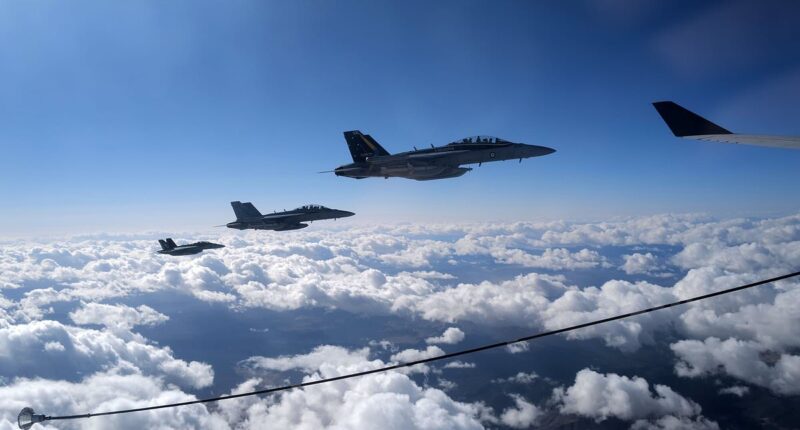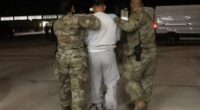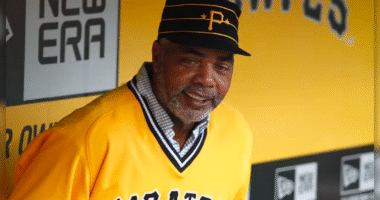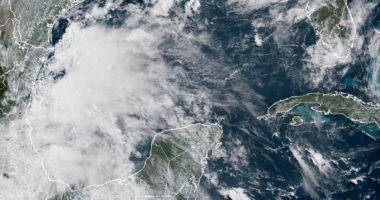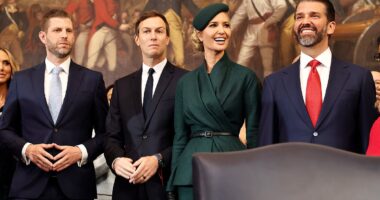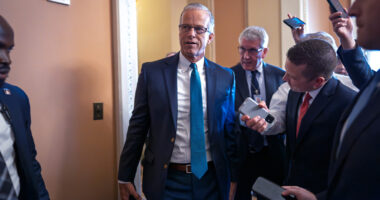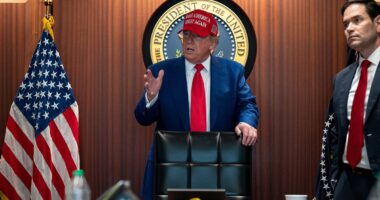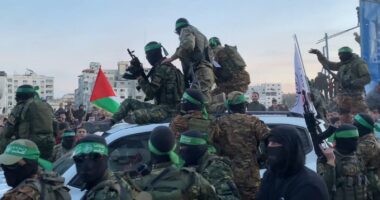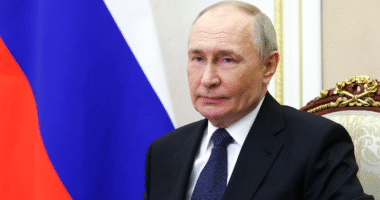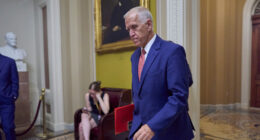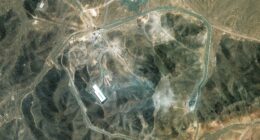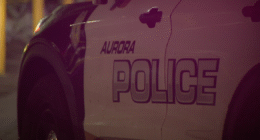
The maneuver plays out like an aerial ballet at 280 knots and 20,000 feet over the Nevada desert.
During a military exercise, a US Marines F-35b Lightning aircraft disconnects its refueling probe from the nozzle being pulled by a Royal Air Force tanker. It then joins two other American planes, while an Australian electronic warfare jet takes its place for refueling.
Meanwhile, as the Royal Australian Air Force Growler refuels and takes in 5000 pounds of fuel, the three F-35s climb higher into the sky. They later veer sharply to the left and pick up speed as they head towards the sun.
They are crammed with all the latest fighting technology, so secret that DailyMail.com is later told it cannot publish pictures of the American jets.
Welcome to Exercise Red Flag, an annual simulation where U.S., British, and Australian pilots practise fighting together.
For many years, this scenario has played out, continuously evolving to address the ever-changing global threats. Presently, the focus is on ‘pacing threats’— nations that have the potential to challenge the supremacy of the United States but are not an immediate military concern.
Think China or Russia.
And if that wasn’t a clear enough hint about the enemy’s identity, Operation Bamboo Eagle follows, moving the action out across the eastern Pacific. It adds what planners call the ‘tyranny of distance,’ simulating the difficulty of fighting a long way from home.
‘For a lot of my career, Red Flag was focused on a desert theater. Now we’re transitioning to a pacing threat,’ said Col. Eric Winterbottom, commander of the 414th Combat Training Squadron which represents the ‘enemy.’
‘We are presenting very high-end capabilities that rival our own, giving our folks the opportunity to integrate to defeat those threats.
Where once it might have focused on training to take on an insurgency in Afghanistan or Iraq, now it is all about what strategists call ‘great power competition.’ Instead of Taliban gunmen in caves, imagine huge Chinese aircraft carriers or their latest fighter jets.
Red Flag has operated since 1975, born out of a realization that pilots were simply not combat ready when they took to the skies of Vietnam. At times, the world’s most powerful air force was losing more planes than the Northern Vietnamese.
The result was an exercise designed to be more realistic than ever before.
Winterbottom’s crack U.S. pilots fly mostly F-16s. Their job is to represent the red forces.
Up against them, the Brits, Aussies and Americans of the blue forces are tasked with first pushing back the red air forces and carving out air space for the next phase.
‘They also have to push back the enemy surface to air missiles through our suppression of enemy air defense role,’ he said.
‘And then we’ll have strikers go in, and those strikers will either be bombing pre-planned targets, along with dynamic targets, which in our scenario present a moving target, typically that will move somewhere and then stop.’
All of that happens over hundreds and hundred of miles. That is where the RAF Voyager and its tons of aviation fuel comes in.
It banks left and left and left as it stays in position outside the battle space, far from the hostile red forces, but close enough for its more than 120,000 lb of fuel to keep the blue fighters in the battle.
The voyager is based on the Airbus A330, but has a different set of wings to accommodate extra fuel tanks and the refuelling system.
It can stay in the air for as long as 12 hours if it needs to.
Fl. Lt Jason Alty, the plane’s captain, is waiting for a pair of RAF Typhoons to rendezvous.
‘Once refuelling is complete, then they can stay in the fight to the very end,’ he said.
Behind him, a colleague is watching a bank of monitors which he uses to guide in the thirsty warplanes.
Earlier, Fl. Lt. Calum Falconer, a Typhoon pilot, described some of the differences he found coming from a smaller air force and working with Americans.
‘We brought to the table the attitude of having one tool that fits many locks,’ he said. ‘And they’ve got their way of looking at things which is a lot more bespoke.
‘They can use more specialized capabilities for more specialized nuts to crack as well.’
The Voyager is an example. It is equipped inside as if it were still a passenger jet, so it can operate in a dual role as troop transport and fuel tanker.
Two Typhoons come into view behind the left wing in the last refuelling dance of the day.
After that it is home to Nellis Air Force base just outside Las Vegas for a debrief.
For Winterbottom, the key is ensuring that the different forces can work together in a world where one day there could hundreds of F-35s stationed in Europe, but where only a few dozens are operated by the U.S.A.F.
‘Multinational integration is key,’ he said. ‘We win future conflicts as a coalition.’
